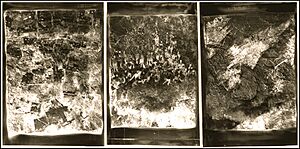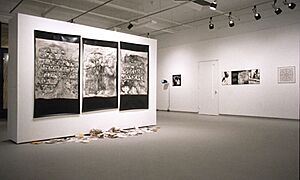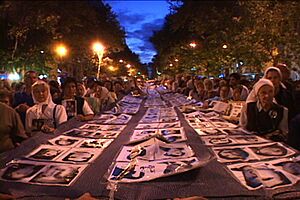Silvia Malagrino facts for kids
Quick facts for kids
Silvia A. Malagrino
|
|
|---|---|
| Born | 1950 Buenos Aires, Argentina
|
| Nationality | American, Argentine |
| Education | University of Illinois at Chicago, Alliance Française de Buenos Aires |
| Known for | Filmmaking, photography, multimedia |
| Style | Postmodern, interdisciplinary |
| Spouse(s) | Pam Bingham |
| Awards | Guggenheim Foundation, National Endowment for the Arts, Illinois Arts Council |
Silvia A. Malagrino, born in 1950 in Buenos Aires, Argentina, is an American artist, filmmaker, and teacher. She lives in Chicago, Illinois. She is famous for her art that mixes different styles and ideas. Her work often looks at history, culture, and how facts, stories, and memories connect.
Her experimental film, Burnt Oranges (2005), used personal stories, witness accounts, and interviews. It also mixed real and re-created scenes to show the lasting effects of Argentina's Dirty War. Malagrino's art has been shown in many places. These include The Art Institute of Chicago and the Palais de Glace in Buenos Aires. Her work has also been recognized by important groups like the Guggenheim Foundation. Malagrino is a Professor of Photography and Moving Image at the University of Illinois at Chicago.
Contents
Silvia Malagrino's Life Story
Silvia Malagrino was born in Buenos Aires, Argentina, in 1950. In 1971, she finished her studies at Alliance Française de Buenos Aires. She became a professor of French language and literature. From 1971 to 1975, she studied literature at the Universidad de Buenos Aires. However, the university closed during the Dirty War. This was a time in Argentina when many people were harmed or went missing.
Because of the censorship during this time, Malagrino started learning photography. After a close friend disappeared, she left Argentina in 1978. She lived in Philadelphia until 1981, where she took photography classes. Since 1982, she has lived and worked in Chicago. She taught photography at Columbia College Chicago from 1982 to 1985. In 1987, she earned her master's degree from the University of Illinois at Chicago. From 1987 to 1990, Malagrino was a guest artist at the School of The Art Institute of Chicago. During this time, her art began to be shown widely. In 1990, she became a faculty member at the University of Illinois at Chicago.
Her Amazing Art Work
Malagrino started her career making experimental photographs. She used special methods like montage (putting pieces together) and collage (gluing different materials). She also used found pictures, chemical changes, and hand-marking. In the 1990s, she began creating art for specific places. These installations included digital photos, large murals, and written words. Around 2000, she started making experimental videos. Her video, The Stream of Life, won a top award in New Media at the Florence Biennale of Contemporary Art in 2005.
Early Photos and Installations
Experts say Malagrino's early black-and-white photos helped her express feelings about memory and dreams. She combined smaller pieces to create large artworks. These often focused on the human body, nature, and ancient ideas. She sometimes changed the original images to create new, interesting designs. One critic described her work as a "rich mix of textures and layered images." This art showed how people survive tough times. Her 1992 "Habitat" series (shown above) explored ideas of power and land. It used images that looked like maps or spiritual figures.
Malagrino's installations have explored how global histories, memories, and human actions connect. Her multimedia work Between Times/Between Worlds (1995) layered visuals and sounds. It used special lighting to weave together personal, cultural, and political stories from North and South America. Inscriptions in the War Zone (1996–8) combined photos and text. It showed the feeling of absence, especially of people who were missing. The art used small clues like fingerprints or bloodstains. It also showed old photos of lost loved ones. This work made people think about how we remember sad events and what "facts" really mean.
The Film Burnt Oranges
In her documentary film, Burnt Oranges (2005), Malagrino went back to Argentina. She wanted to explore the hidden story and effects of the Dirty War. She looked at how personal memories can differ from official facts. The film took about seven years to complete.
Critics compared the film's style to other famous experimental filmmakers. It mixed metaphors and poetic stories based on letters. It also included interviews with people who survived torture. Families of those who disappeared, journalists, and military officers were also interviewed. The film used both real and re-created footage. Reviewers noted that the film showed the terrible impact of state violence. But it also showed human strength and the fight for human rights. Groups like the Mothers of the Disappeared worked to heal their society. Burnt Oranges won the CINE Golden Eagle Award in 2005. It also won Aurora Awards for Directing and Best Cultural Documentary in 2007.
Later Films and Multimedia Art
In 2013, Malagrino created a special one-night art show called Swimming With a Kite. She worked with artists Joshua Albers and Jesus Duran. This project was inspired by a book she found with many notes and drawings. She thought these notes were like visual poetry. Swimming With a Kite used video, light, and computer programming. It created an environment for people to explore and think about language, images, and the book's ideas.
Malagrino also worked with filmmaker Sharon Karp on the documentary A Song for You (2014). Malagrino was a co-director, co-writer, and co-producer. The film tells the story of Karp's family. They walked across the Pyrenees mountains for five years to escape the Nazis. The film shows how the Karp sisters faced their family's past. Like Malagrino's other work, this story is told in many ways. It uses interviews, parts of a book, home movies, photos, and historical footage.
Awards and Art Collections
Silvia Malagrino has received many awards and grants for her work. These include fellowships from the John Simon Guggenheim Memorial Foundation (2010). She also received grants from the National Endowment for the Arts (2004, 1994, 1993). The Illinois Arts Council has given her seven awards between 1987 and 2013. In 2012, she was named a Distinguished Artist by the State of Illinois.
Her art is part of important collections around the world. These include the Bibliothèque nationale de France and The Art Institute of Chicago. Her work is also in the Milwaukee Art Museum and other universities and libraries.




